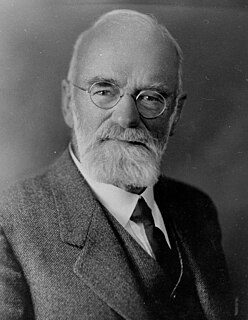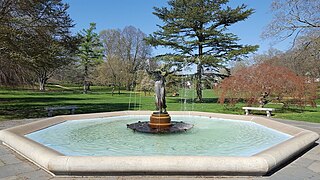
Wilcox Park is a park and arboretum located at 71 ½ High Street, Westerly, Rhode Island. It is open to the public at all times, without fee, and has been on the National Register of Historic Places since 1973 as Wilcox Park Historic District. The historic district includes 84 houses/buildings of the neighborhood surrounding the park covering a 50-acre (20 ha) area, including the main post office and library of the town of Westerly.

The Mechanic Street Historic District encompasses a historic 19th-century mill and mill village in a 14-block area of the Pawcatuck section of Stonington, Connecticut. Extending along the Pawcatuck River and south of West Broad Street, the area includes a large brick mill complex on the banks of the river, and a neighborhood of well-preserved worker housing on the road grid to its west. The district was listed on the National Register of Historic Places in 1988.

The Roger Williams National Memorial is a landscaped urban park located on a common lot of the original settlement of Providence, Rhode Island, established by Roger Williams in 1636, bounded by North Main, Canal, and Smith Streets, and Park Row. The memorial commemorates the life of the co-founder of the Colony of Rhode Island and Providence Plantations and a champion of the ideal of religious freedom. Williams was banished from the Massachusetts Bay Colony for his beliefs, and he founded this colony as a place where all could come to worship as their conscience dictated without interference from the state. This park is the 20th smallest National Park System unit in the nation.

The Bellevue Avenue Historic District is located along and around Bellevue Avenue in Newport, Rhode Island, United States. Its property is almost exclusively residential, including many of the Gilded Age mansions built by affluent summer vacationers in the city around the turn of the 20th century, including the Vanderbilt family and Astor family. Many of the homes represent pioneering work in the architectural styles of the time by major American architects.
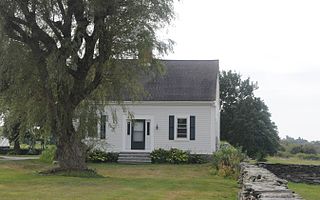
The Bailey Farm is an historic farm at 373 Wyatt Road in Middletown, Rhode Island. Now reduced from more than 100 acres (40 ha) to about 45 acres (18 ha), the farm is a well-preserved example of a 19th-century island farm. It was owned by members of the Bailey family, possibly as early as the late 17th century, into the 19th century. The original main house appears to be a mid-18th century structure that was given a significant Greek Revival treatment in the 19th century. It is a 1-1/2 story Cape style house, three bays wide, with a central chimney. The main entrance is centered on the northern facade, and is flanked by sidelight windows and pilasters, with an entablature above. The corners of the building are pilastered. A series of outbuildings stand nearby. There is a second complex of buildings on the northwest part of the property, built in the 1930s near the location of the Bailey family cemetery.

The Andrews–Luther Farm is an historic farm in Scituate, Rhode Island. It is located on the south side of Elmdale Road, a short way east of its junction with Harmony Road. The farm is a 45-acre (18 ha) property, with its main house, a c. 1768 wood frame structure set near the road. It is 2-1/2 stories high, with a large central chimney, and a center entry on the south facade with vernacular Greek Revival styling. A corn crib dating to the late 19th or early 20th century stands further south on the property, and the foundational remains of older buildings dot the area. The farm is distinctive for retaining a large portion of its original setting, and for the detailed accounts of it which have been retained by Harley Luther's descendants.
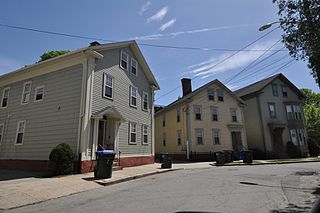
The Bridgham–Arch–Wilson Streets Historic District is a predominantly residential historic district in Providence, Rhode Island. It is located southwest of downtown Providence, and was developed beginning in the 1840s as a suburban part of the city. It is roughly in the shape of a boot, roughly bounded by Cranston, Bridgham, Elmwood, and Harrison Streets. Most of the housing is architecturally reflective of the mid-19th century, with the Greek Revival, Italianate, and Second Empire styles well represented. Development in the area slowed in the late 19th and early 20th centuries, so there are only a modest number of Queen Anne, Stick style, and Colonial Revival properties. Most of the houses are either 1-1/2 or 2-1/2 story wood frame structures, and are generally set on fairly small lots. There are 175 primary buildings in the district, of which more than 150 are historically significant.

The Wayland Historic District is a predominantly residential historic district on the east side of Providence, Rhode Island. It is a large area, covering about 122 acres (49 ha), bounded roughly on the north by Everett and Laurel Avenues, on the east by Blackstone Boulevard and Butler Avenue, on the west by Arlington Avenue, and on the south by Angell and South Angell Streets. This area, which was in the 19th century part of the Moses Brown farm, was platted for development in 1891, with most of the construction taking place in the early decades of the 20th century. Most of the residential properties in the district are single-family houses, typically built in revival styles popular at the time. They are set on similarly-sized lots with fairly uniform setbacks, and were typically built without garages. There are a number of two-family houses, and a small number of apartment buildings, most of which are found on the arterial roads of the area. There are several religious buildings, including several churches; the most architecturally distinctive religious building is the Jewish Temple Beth El, built 1951-54.
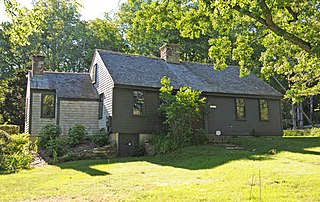
The Lewis–Card–Perry House is a historic house at 12 Margin Street in Westerly, Rhode Island.

The Commodore Oliver Perry Farm is an historic farm on United States Route 1 in South Kingstown, Rhode Island. The farm consists of 250 acres (100 ha) of rolling fields and woodlands on the west side of the road. The main farm complex includes a wood-frame house, barn, a caretaker's residence, and a number of other outbuildings, accessed via a winding private lane. The main house, a two-story gambrel-roofed structure, is of uncertain construction date, and is generally dated to either 1785 or 1815. It has been extensively altered, and been the subject of well-meaning but historically problematic restorations in the first half of the 20th century.
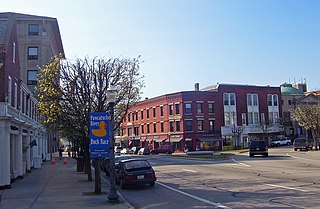
The Westerly Downtown Historic District is a historic district encompassing most of the commercial and civic district of Westerly, Rhode Island, United States. It extends from Broad and Union Streets eastward along High Street, and north along Canal Street to Railroad Avenue, where it extends to include the historic railroad station. The district contains a compact and cohesive collection of commercial and civic buildings built primarily during the last three decades of the 19th century and the first three decades of the 20th century, including the Old Town Hall (1872–74), the current Town Hall (1912), the Spanish Colonial railroad station (1912), and the Greek Revival post office (1914).
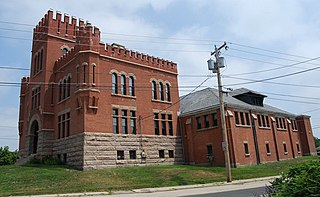
The Westerly Armory is an historic National Guard armory building located on Railroad Avenue, west of downtown Westerly, Rhode Island.

The South Main Street Historic District is a historic district in Coventry, Rhode Island. It extends along South Main Street from its crossing of the South Branch of the Pawtuxet River in the north, to just below Wood Street in the south, and includes a few properties on immediately adjacent streets. The area is almost entire residential, and was developed in the 19th century, providing housing for middle-class workers not directly affiliated with the mills that lined the river. About half the houses were built before 1850, and exhibit either Federal or Greek Revival styling, while most of the remaining houses were built before 1920. The principal non-residential structures are a VFW hall, which began as a mid-19th century residential structure associated with Rhode Island's prominent Whipple family, the Stillwater Company mill at the northern end of the district (1914), and the three-room Cady Street Schoolhouse (1844).

White Farm is a historic farm property on Clinton Street in Concord, New Hampshire. Located about two miles (3.2 km) west of downtown Concord, the farm is now owned by the state, but includes a number of historically significant buildings, and is one of the largest open space areas in the city near its downtown. It was listed on the National Register of Historic Places in 1981.

The Farm House is a historic summer estate at 15 Highbrook Road in Bar Harbor, Maine. The estate includes a 19th-century farmhouse which was extensively altered in the 1920s to Colonial Revival designs by Arthur McFarland, who also designed a caretaker's cottage on the property. The property also includes a series of garden spaces designed by Beatrix Farrand. This work was done for Mildred McCormick, an heir to the fortune of Cyrus McCormick, inventor of the combine harvester. The estate was listed on the National Register of Historic Places in 2007.

Ram Point is a historic summer estate property at 77 Watch Hill Road in Westerly, Rhode Island. It is located at the head of an eponymous geographic features, which projects into the Pawcatuck River between downtown Westerly and the Watch Hill area. The property includes a suite of buildings, the principal one being a large two story Colonial Revival wood frame building. The house was built c. 1903 for Dr. John Whitridge Williams to a design most likely by Douglas Thomas, Jr. of Baltimore, Maryland. The property is believed to be one of only two Rhode Island works by Thomas; the other, also designed for a member of the Williams family, is located across Babcock Cove from Ram Point.

The Capitol Complex Historic District encompasses the principal historic elements of Maine's state administration complex at Capitol and State Streets in Augusta, Maine. Included in the district are the Maine State House, Capitol Park, The Blaine House, the Burton Cross Office Building, and a number of state-owned 19th century residences in the vicinity of the Blaine House. The district was listed on the National Register of Historic Places in 2001.

Rockledge is a historic summer estate house on Vermont Route 207 in Swanton, Vermont. Architect Charles Saxe in 1918 designed alterations to an early 19th-century farmhouse, that is the principal surviving element of an early 20th-century gentleman's farm. The property was listed on the National Register of Historic Places in 1994.
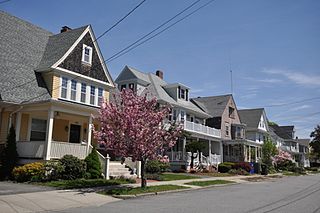
The Edgewood Historic District–Sally Greene Homestead Plats is a residential historic district in the Edgewood neighborhood of eastern Cranston, Rhode Island. Bounded by Glen Avenue to the north, Broad Street to the west, Massasoit Street to the south, and the Providence River to the east, this area was developed between 1900 and 1963 as a streetcar suburb for middle and lower middle class residents on what was once a country estate. The district was listed on the National Register of Historic Places in 2016.








